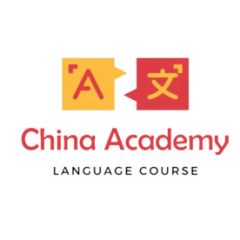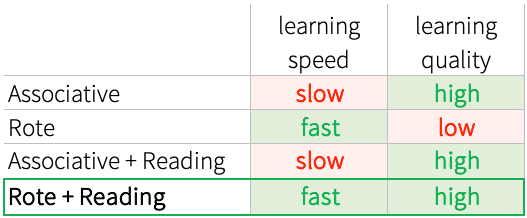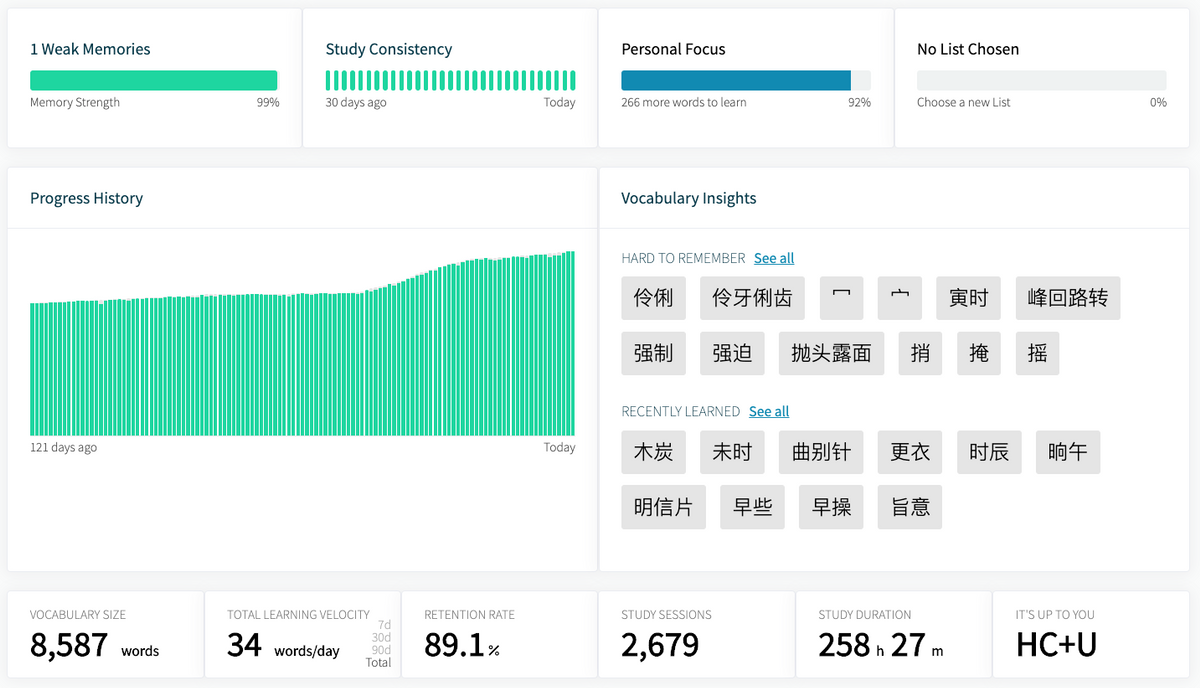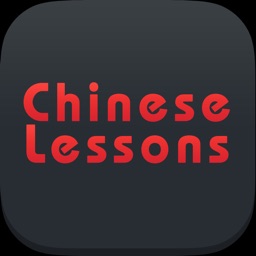Deciding how to learn Chinese vocabulary is one of the most impactful decisions a student must make.
With thousands of words to learn, a method that is even a little bit more efficient could result in hundreds (or even thousands) of hours saved in the long run.
There are two main challenges to learning Chinese vocabulary, and we will look at each one separately, along with specific solutions that will help you overcome them.
Main Challenges of learning Chinese vocabulary
Both issues are related to the structure of most Chinese language courses, and they both affect your long-term outcome.
Challenge # 1 – Forgetting what was learned
Most language courses pay insufficient attention to how well students are retaining what they’ve learned (and focus instead on constantly teaching “new” material).
The consequences of this approach can be severe: over-confident students (“I’ve finished the textbook!”) with large gaps in their knowledge as they forget as fast as they learn.
What’s more unsettling is that most students are unaware how much they’ve forgotten until they find themselves struggling with material that should be easy to them.
If a student finishes a textbook, they should be able to open to any page months later and read it with ease, but this is often not the case.
Challenge #2 – Insufficient volume
For context, the highest level of the HSK (China’s official language proficiency exam) requires knowledge of around five hundred grammar patterns, and five thousand Chinese words.
And yet, when test-takers pass the highest level of the HSK and still find themselves struggling to understand written or spoken Chinese, it is almost always because they don’t know enough vocabulary.
Students who pass HSK 5 or 6 and then try to read “Harry Potter” in Chinese will be in for a rude surprise: there will still be hundreds or thousands of words they don’t know.
How can this be?
Well, it’s quite obvious to everyone who reaches these levels: they haven’t learned enough words. They were never even expected to!
Unfortunately, few Chinese learning curriculums (including the HSK) prepare students with enough vocabulary to do the things they expect to be able to, like read a novel meant for adolescents.
This isn’t to say that the HSK is a “bad” proficiency exam, but rather suggests that it needs to be expanded.
Indeed, the Internet has recently been flush with content about the new version of the HSK exam. The new version has increased the number of levels, while simultaneously increasing the total required vocabulary from 5,000 words to 11,000. This is undoubtedly a step in the right direction.
With these two challenges in mind (not learning enough, and forgetting what is learned), let’s explore how to practically solve the vocabulary problem.
Practical Techniques to learn Chinese vocabulary effectively
Technique #1 – Focus on Retention
No matter how good your learning strategy is, your long-term results will be suboptimal unless you have a good retention strategy (to remember what you learned).
Forgetting is a great way to maximize frustration; not only must you re-learn what you forgot, but you have to do it knowing that your initial efforts were wasted.
Unfortunately, unless you are constantly surrounded with Chinese language (like a child being forced to interact with adults for food or attention), even the most well-intentioned, ambitious students are likely to forget a majority of the Chinese vocabulary they study.
“But,” you might say, “my textbook repeats new words in future lessons, won’t this keep all my memories strong?”
Unfortunately, it won’t. The volume of Mandarin words you learn is far greater than could be reasonably stuffed into the dialogues of your textbook with sufficient repetition to make it all stick.
Smart students supplement their Chinese vocabulary learning with graded readers (a practice we highly recommend), but for most students who can’t read for hours a day, even this won’t be enough.
So how can you make sure you remember everything you learn? Spaced repetition.
Spaced Repetition
Often considered a learning methodology, we think spaced repetition is more of a retention methodology, that happens to be so good at retention, it can be used as a learning methodology, too.
Spaced repetition algorithms track every word you learn, and then schedule reviews after ever-increasing intervals as your overall familiarity with each word grows.
A common concern of students who haven’t yet fallen in love with spaced repetition for learning Chinese vocabulary is that they will spend too much time reviewing.
But the reality is the precise opposite: because your reviews are timed to occur only when you’re at risk of forgetting something, spaced repetition algorithms enable you to spend the least amount of time reviewing, while still keeping your memories strong.
In turn, you are then able to spend the maximum amount of time possible with other learning activities (like reading, speaking, etc.), all while being confident that you aren’t at risk of forgetting something you’ve already learned.Spaced repetition is so exciting, we have an entire article devoted to it here.
Technique #2 – Study Chinese vocabulary every single day
You might be thinking, “Isn’t this common sense? Of course, doing something every single day will yield better results!”
True. But vocabulary deserves special attention for two reasons:
- Vocabulary enables all of your other learning and practice methods. For example, you can’t learn grammar patterns or read without first learning the vocabulary.
- There is more raw vocabulary than grammar patterns, idioms, and everything else combined.
Because growing your Chinese vocabulary is so foundational to learning Chinese, you should aim to devote at least ten minutes per day to vocabulary growth.
How should you actually go about learning Chinese vocabulary every day? There are two main learning paradigms: associative and rote.
Associative learning
Associative learning essentially means connecting new knowledge to other (usually more interesting) knowledge in order to help you remember it.
In the context of learning Mandarin vocabulary, “more interesting” knowledge might be:
- a story you (or someone else) invented to provide meaning to the characters
- an understanding of the components that make up the characters (all with their own stories), that come together to provide meaning
- an artistic embellishment of each Chinese character, to make their meaning more obvious
Studies have shown that association-based learning is very powerful, as the more the new memory can latch onto, the more likely you are to retain it for a long time.
A potential disadvantage to associative learning, besides needing to first learn how to apply the technique effectively, is the additional burden of needing to memorize everything you are associating the new knowledge with. Many practitioners, however, don’t cite this as a problem.
Rote learning
Rote learning is a (terribly uncool) term for repetitious learning, usually defined with words like “brute force memorization” or “boring”.
And that’s not entirely wrong: it is essentially testing your memory over and over until you can consistently remember the Chinese vocabulary you’ve learned.
The main advantage to rote learning is that there’s no technique to learn, and because there is so little to do, it’s extremely fast at installing short-term memories.
A disadvantage of rote learning is that you won’t have as deep an understanding of what you are learning. Without timely review, you are more likely to forget what you learned.
What’s the best way to learn Chinese vocabulary?
Both associative and rote learning methods work to learn Chinese vocabulary. Both learning methods have produced great students with large, strong vocabularies.
And both methods have the same goal: effortless familiarity with words that enables instant recall of their pronunciation and meaning, long after you first learn them.
A lot of learn-Chinese-character programs promote associative learning methods as the only way to go. And for the reasons mentioned above, we agree that associative learning methods can be extremely effective.
However, many people actually prefer rote learning methods, and there are strong reasons why.
Consider that by the time you truly “master” the words you are learning, you will have lost the necessity for whatever infrastructure you used to get there:
- If you made stories to learn every new word, you may still remember the stories you created, but you (hopefully) don’t need them anymore.
- If you learned by rote repetition and have tested yourself on the word 20+ times over several months or years, you (probably) don’t need to keep testing yourself.
This being the case, by what measure should you evaluate learning methods and choose one that is right for you?
The sooner you can read, the better
For most students, learning new Chinese words is simply a stepping stone towards something more meaningful: being able to read, write, listen and speak in Chinese.
In that context, we think the below assertions are pretty obvious:
- Reading is the best way to get better at reading.
- Speaking is the best way to get better at speaking.
- Listening is the best way to get better at listening.
- Writing is the best way to get better at… well, you get the point.
Assuming you want to be able to read, write, speak, and listen, you best plan to spend a lot of time doing them!
The sooner you can get to these activities, the better.
Rote learning will get you reading sooner
Although rote learning is very fast, it doesn’t achieve the ‘deep understanding’ that comes with some forms of associative learning methods, especially if your only learning activity is learning new words atomically:
But remember, your real goal isn’t just to learn words. Your real goal is to actually use the Chinese characters you are learning. For example, by reading.
Let’s add ‘reading’ onto both methods:
Why does rote + reading get the same high quality score that associative does? Because reading helps solidify your familiarity with the words.
Rote + Reading creates a positive feedback loop: quickly learning words with rote learning lets you read more material sooner, reading then helps strengthen your understanding of the words you learned, your strengthened understanding then make rote learning become quicker and easier, which lets you learn faster and read more, etc.
Is rote “better” for learning Chinese vocabulary than associative?
That’s for you to decide. As mentioned earlier, associative learning methods have do have a few advantages. And, if the associative learning methods you use are based on the radicals and components of the words you are learning, it might deepen your connection with the language.
But we think associative learning methods should be saved for characters and words you can’t seem to remember, and not used for every word you learn.
Why? Because you can learn most characters quickly and easily without it.
Fast and Furious: Learning vocabulary with Hack Chinese
Rote learning with spaced repetition can dramatically increase your Chinese vocabulary in a short period of time.
How fast?
I learned 565 new words in 20 days!
Max Hobbs, LTL Mandarin, Beijing, China
If you’re a longtime fan of associative learning, try unleashing yourself for a week and try rote learning with a spaced repetition tool like Hack Chinese.
Many students find it easier, and more exciting to progress, and that helps you get to more challenging learning activities (like reading or watching television) a lot sooner.
Hack Chinese is a retention-first spaced repetition platform for learning Chinese vocabulary online. (Retention-first means that retaining strong mastery of words you have previously learned is given priority over learning new words.)
Callan Quinn, Live the Language School, Beihai, China
To uncover the full potential of Hack Chinese for boosting your vocabulary memorization, check out the video below. This 6-minute video created by ExcelMandarin provides a comprehensive overview of Hack Chinese and its features:
Conclusion
Choose your vocabulary learning strategy carefully, and you can save yourself an enormous amount of time.
The more your Chinese vocabulary grows, the easier your learning journey becomes, so make sure you choose a method and a platform that you can use daily and stick with for long enough for your effort to matter.








